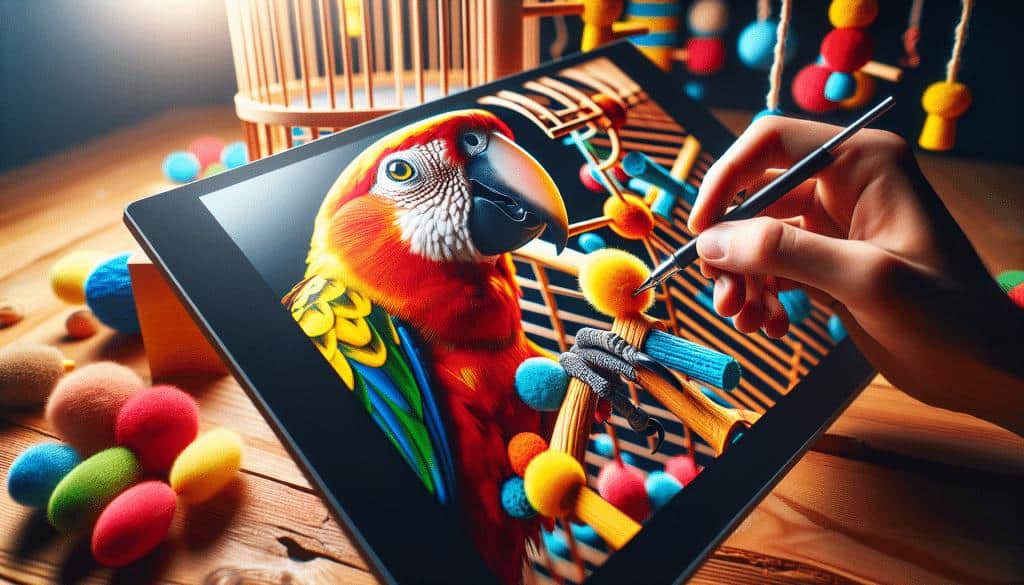So, you’ve finally decided to bring home a beautiful parrot as your newest feathery companion. But before you can embark on this exciting journey, there’s one crucial aspect you need to address – creating the perfect parrot habitat. In this guide, we will explore the essential factors to consider while setting up your parrot’s cage. From the size and design of the cage to the essential accessories and perches, we’ll ensure your parrot’s living space is not only safe and comfortable but also stimulating and enriching for their overall well-being. Get ready to transform your parrot’s cage into a delightful sanctuary they will call home!

Understanding Parrot Species and Their Habitat Needs
When it comes to parrot ownership, understanding the specific needs of your feathered friend is crucial. There are several different parrot species, each with their own unique characteristics and habitat requirements. By identifying the type of parrot you have, you can ensure that their living environment caters to their specific needs.
Identifying the Type of Parrot
Before diving into the intricacies of parrot habitat setup, it’s important to correctly identify the type of parrot you own. From the small and charming budgerigar to the majestic and colorful macaw, parrots come in all shapes and sizes. Knowing the species of your parrot will help you make informed decisions regarding their habitat.
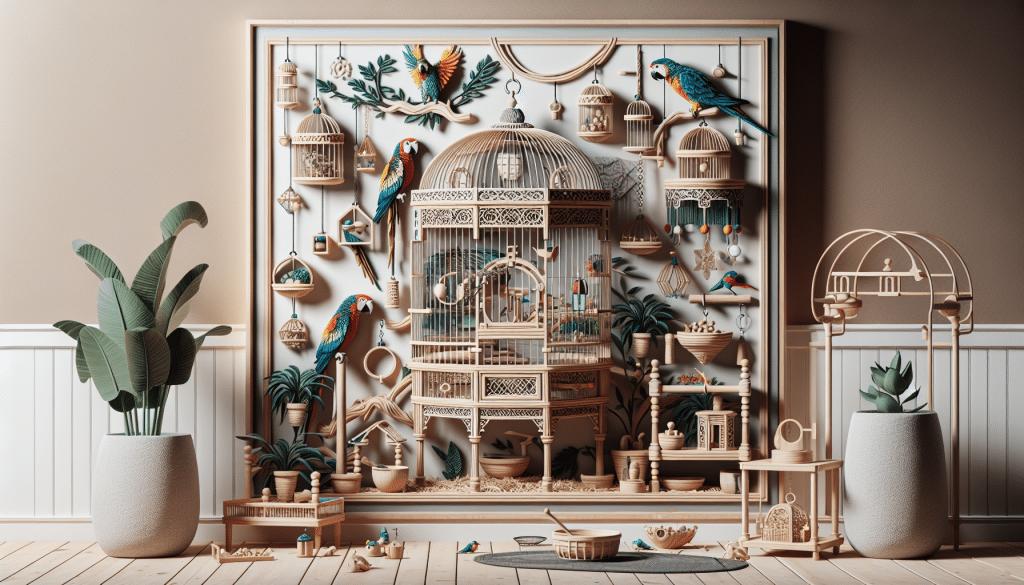
Natural Habitats of Different Parrot Species
Parrots originate from various regions around the world, and their natural habitats reflect this diversity. Some species, like the African Grey Parrot, hail from dense rainforests, while others, such as the Cockatoo, are native to arid Australian woodlands. Understanding the natural habitat of your parrot species can provide valuable insights into their preferred living conditions.
Space Requirements According to Parrot Size
Parrots require ample space to thrive and exhibit natural behaviors. The size of the cage you choose should correspond to the size of your parrot. Smaller parrots, like budgies and lovebirds, can do well in cages around 18-24 inches wide, while larger species, such as macaws and cockatoos, will need significantly larger enclosures. Always prioritize providing as much space as possible within your means.
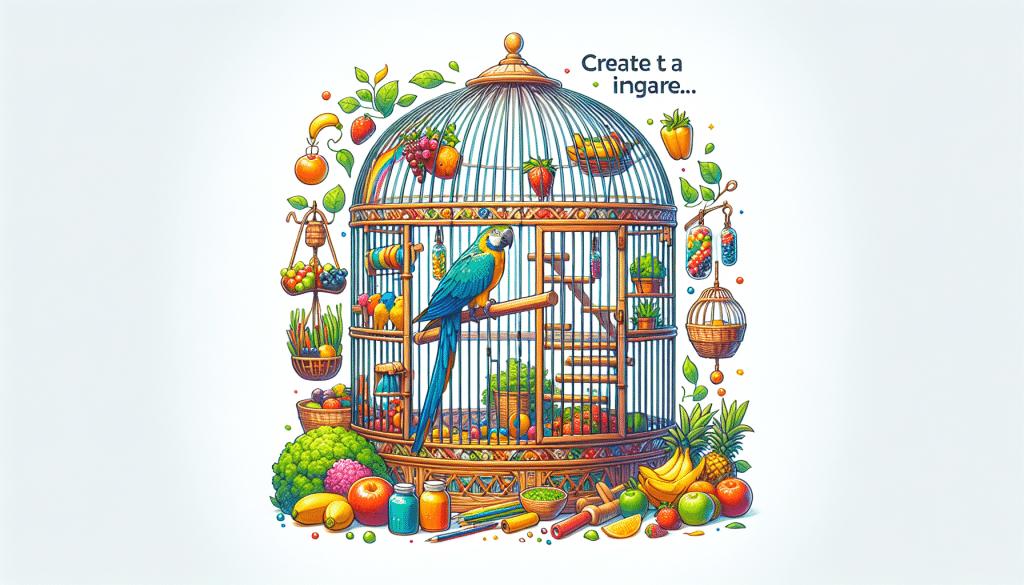
Choosing the Right Cage
Now that you have a good understanding of your parrot’s needs, it’s time to select the perfect cage. There are several factors to consider, including the material and durability, size and shape considerations, bar spacing and orientation, and ease of cleaning.
Material and Durability
When choosing a cage, opt for one made from sturdy and non-toxic materials. Stainless steel cages are often considered the gold standard, as they are long-lasting, easy to clean, and safe for your parrot. Avoid cages made of materials like lead or zinc, as they can be harmful to your feathery friend.
Size and Shape Considerations
Ensure that the cage you choose allows for ample movement and exercise. Your parrot should be able to spread its wings fully without hitting the sides of the cage. Additionally, consider the shape of the enclosure. While rectangular or square cages are the most common, some parrots, like cockatiels, prefer taller cages that allow them to climb.
Bar Spacing and Orientation
Parrots are curious and intelligent creatures, and they may try to squeeze through bars that are too widely spaced. Choosing a cage with appropriate bar spacing is essential to prevent escape or injury. As a general rule of thumb, the gap between bars should be no wider than the width of your parrot’s head. Additionally, ensure that the bars are horizontal, as this allows for climbing and exercising.
Ease of Cleaning
Regular cleaning is vital to maintaining a healthy and hygienic environment for your parrot. Look for cages that are easy to disassemble and clean thoroughly. Removable trays are especially convenient for quick and efficient waste removal. Consider the accessibility of the cage components to ensure that you can reach every nook and cranny without difficulty.
Essential Cage Safety Features
Creating a safe and secure environment within the cage is paramount to the well-being of your parrot. There are several key safety features to consider, such as locks and latches, avoiding hazardous materials, creating a safe flying environment, and preventing escape and injury.
Locks and Latches
Ensure that your cage is equipped with reliable locks and latches to prevent accidental openings. Parrots are highly intelligent and may find ways to unlock or manipulate poorly secured doors. Invest in high-quality locks that are secure and can withstand the curious nature of your parrot.
Avoiding Hazardous Materials
Parrots are notorious for chewing on various objects, so it’s crucial to avoid using any materials that could be toxic or harmful. For example, steer clear of cages with lead-based paint or galvanized materials. Instead, opt for non-toxic and bird-safe finishes that are specifically designed for use in parrot habitats.
Creating a Safe Flying Environment
Although your parrot’s primary enclosure is the cage, they still need ample opportunities for flight and exercise. Parrots with ample space to spread their wings and fly are generally healthier and happier. Consider setting up a separate area outside of the cage for supervised flight time and provide plenty of perches and climbing opportunities to mimic their natural environment.
Preventing Escape and Injury
Parrots are expert escape artists, and it’s essential to carefully evaluate the cage to ensure there are no potential escape routes. Check for any gaps, loose wires, or doors that don’t seal properly. Additionally, remove any sharp or dangerous objects inside the cage that could cause injury to your parrot.
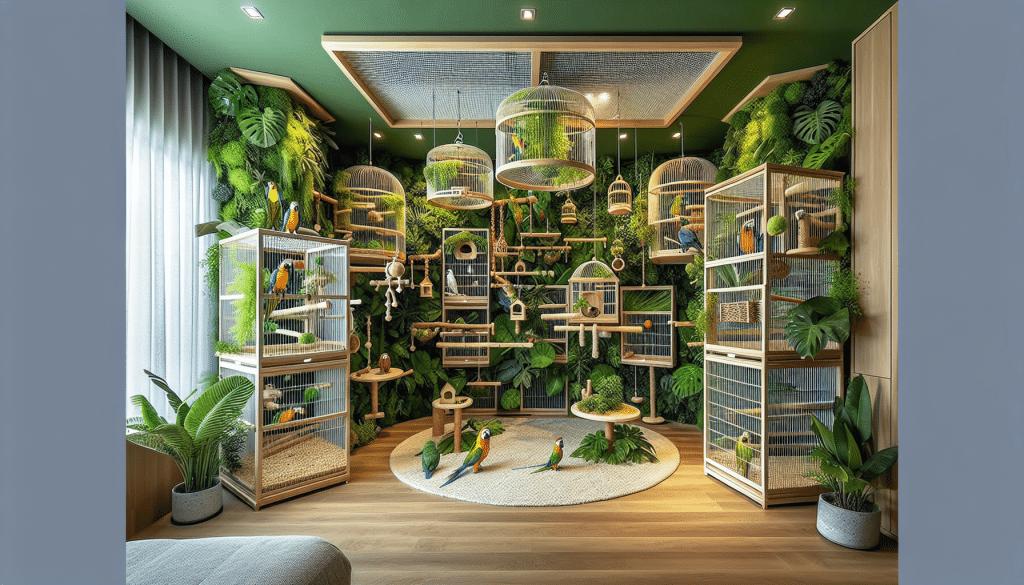
The Importance of Proper Cage Placement
Now that you have chosen the ideal cage and ensured its safety features, it’s time to think about where to place it within your home. Proper cage placement is crucial for your parrot’s overall well-being and happiness. Consider factors like location in the home, lighting and sunlight exposure, avoiding drafts and extreme temperatures, and noise levels and social interaction.
Location in the Home
Select a location in your home that allows your parrot to feel part of the family while still providing a sense of security and calm. Avoid placing the cage in noisy or high-traffic areas, as this can cause stress for your feathered friend. Instead, choose a quiet area where your parrot can observe their surroundings and engage with the family.
Considering Lighting and Sunlight Exposure
Parrots require exposure to natural light to maintain their well-being. Place the cage in a room with ample natural light, but ensure that it is not in direct sunlight, as this can cause overheating. Find a balance between providing access to sunlight and incorporating artificial lighting to simulate natural day-night cycles.
Avoiding Drafts and Extreme Temperatures
Parrots are sensitive to changes in temperature, so it’s important to avoid placing their cage near drafts or in areas with extreme temperature fluctuations. Keep them away from windows, doors, air conditioning vents, or radiators that could expose them to chilly drafts or uncomfortably hot conditions.
Noise Levels and Social Interaction
Parrots are highly sociable creatures that thrive on interaction. Place the cage in an area where your parrot can observe and engage with the family. However, it’s important to strike a balance to avoid overwhelming noise levels that could stress or disturb your parrot. Consider the overall noise level in your home and find a spot where your parrot can enjoy interaction while still having a quiet retreat.
Setting Up the Interior of the Cage
With the cage positioned in an ideal location, it’s time to focus on creating a comfortable and stimulating interior environment for your parrot. Consider factors like perches, size, types, and placement, utilizing vertical space for exercise, installing feeders and waterers, and appropriate substrates for the cage flooring.
Perches: Size, Types, and Placement
Perches are essential for your parrot’s comfort and physical health. Choose perches of varying sizes to promote foot exercise and prevent foot problems. Opt for natural branches or perches made from safe materials like stainless steel or bird-safe wood. Place the perches at different heights and orientations to encourage exercise and mimic the diverse environments found in the wild.
Utilizing Vertical Space for Exercise
Parrots are highly active and enjoy climbing and exploring their surroundings. Utilize the vertical space within the cage by adding ladders, ropes, and swings to encourage physical activity. This not only provides exercise but also stimulates mental engagement and prevents boredom.
Installing Feeders and Waterers
When setting up the interior of the cage, ensure that you have easily accessible and appropriately sized feeders and waterers. Place them in areas where your parrot can easily reach them without obstacles. Consider using stainless steel or ceramic bowls that are easy to clean and do not pose a risk of toxicity to your parrot.
Appropriate Substrates for Cage Flooring
The flooring of your parrot’s cage should be both comfortable and easy to clean. Avoid using materials like newspaper, as the ink can be toxic to your parrot. Instead, select a substrate that is safe and absorbent, such as paper-based bedding or corncob bedding. Regularly clean and replace the substrate to maintain a clean and hygienic environment for your parrot.
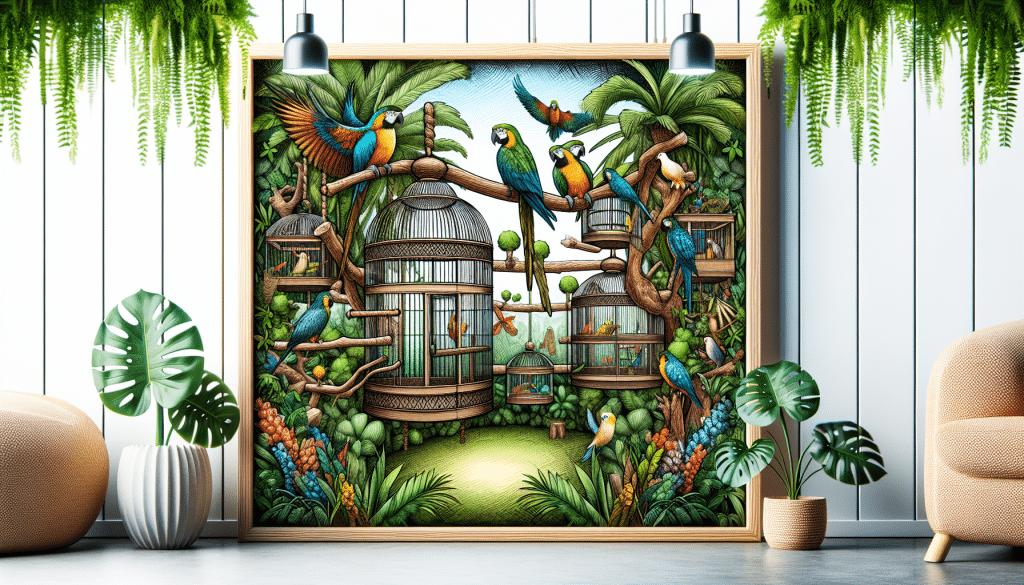
Enrichment and Toys for Mental Stimulation
Parrots are highly intelligent and require mental stimulation to thrive. Enrichment and toys play a crucial role in keeping your parrot engaged and entertained. Consider factors like the selection of safe toys, offering variety and rotation, encouraging foraging behaviors, and DIY enrichment ideas.
Selection of Safe Toys
When choosing toys for your parrot, prioritize safety and durability. Opt for toys made from non-toxic materials that are free from small parts that could be swallowed. Parrots enjoy toys that provide different textures, colors, and challenges. Consider toys that encourage problem-solving, chewing, swinging, and climbing.
Offering Variety and Rotation
To prevent boredom, it’s important to offer a variety of toys and rotate them regularly. This keeps your parrot engaged and prevents them from losing interest in their surroundings. Introduce new toys periodically, and retire toys that show signs of wear or damage. Keeping a rotation of toys will keep your parrot mentally stimulated and entertained.
Encouraging Foraging Behaviors
In the wild, parrots spend a significant amount of time foraging for food. Recreate this natural behavior by incorporating foraging toys into your parrot’s habitat. Foraging toys can be as simple as hiding treats within the cage or more complex puzzle toys that require problem-solving skills. These toys not only provide mental stimulation but also help prevent boredom and obesity.
DIY Enrichment Ideas
You don’t need to break the bank to provide enrichment for your parrot. There are plenty of DIY ideas that can keep your feathered friend engaged and entertained. Consider making homemade foraging toys using cardboard boxes or creating toys from bird-safe materials like untreated wood and natural fibers. The key is to provide variety and keep your parrot’s curious mind engaged.
Incorporating Plants and Nature Elements
Bringing elements of nature into your parrot’s habitat can provide numerous benefits. By incorporating safe plants and natural materials, you can create a visually appealing and stimulating environment for your parrot. Consider factors like choosing safe plants, creating a naturalistic appearance, benefits of live plants in the habitat, and maintenance of plants within the cage.
Choosing Safe Plants
Some plants can be toxic to parrots, so it’s important to research and choose safe options. Plants like spider plants, Boston ferns, and African violets are generally considered safe and can provide visual appeal and additional environmental enrichment. Ensure that the plants you choose are non-toxic and free from pesticides or fertilizers that could harm your parrot.
Creating a Naturalistic Appearance
Transforming your parrot’s cage into a mini natural habitat can enhance their overall well-being. Choose natural materials like untreated wood branches or driftwood to create perches and climbing opportunities. Incorporate items like rocks, shells, or safe natural fibers to add texture and visual interest. These elements simulate the natural environment and provide a sense of security and comfort to your parrot.
Benefits of Live Plants in the Habitat
Live plants offer numerous benefits to your parrot’s well-being. They can enhance air quality by providing oxygen, help maintain humidity levels, and create a visually appealing and dynamic environment. Live plants also offer your parrot the opportunity to observe and interact with nature, stimulating their senses and promoting a sense of tranquility.
Maintenance of Plants within the Cage
Maintaining live plants within your parrot’s habitat requires some care and attention. Ensure that the plants receive adequate light, but avoid exposing them to direct sunlight, as this can cause overheating. Monitor the plants for any signs of pests or diseases and promptly address any issues. Regularly water the plants and remove any dead or dying foliage to maintain a vibrant and healthy environment.
Maintaining a Clean and Healthy Environment
Regular cleaning and maintenance are vital to providing a clean and healthy environment for your parrot. Establishing a cleaning schedule and practicing proper disinfecting and sanitization techniques are essential. Additionally, controlling odor and waste and regularly replacing and refreshing substrates play a crucial role in maintaining your parrot’s well-being.
Regular Cleaning Schedule
Create a cleaning schedule that includes daily, weekly, and monthly tasks to ensure the cleanliness of your parrot’s habitat. Daily tasks may include removing waste, providing fresh food and water, and spot-cleaning any messes. Weekly tasks may involve changing and washing substrate materials and disinfecting perches and toys. Monthly tasks may include a more thorough cleaning of the entire cage and its components.
Disinfecting and Sanitization Practices
To prevent the spread of bacteria or disease, it’s important to incorporate proper disinfecting and sanitization practices into your cleaning routine. Use bird-safe disinfectants that effectively kill harmful bacteria and viruses without posing any risk to your parrot. Thoroughly clean and sanitize the cage and all its components, including perches, toys, and feeders.
Controlling Odor and Waste
Parrots can generate a significant amount of waste, which can contribute to odor if not properly managed. Regularly remove waste and clean soiled areas to prevent odor buildup. Consider using odor-neutralizing products designed specifically for pets to maintain a fresh and pleasant environment for both you and your parrot.
Replacing and Refreshing Substrates
The substrate in your parrot’s cage plays a crucial role in maintaining cleanliness. Regularly replace and refresh the substrate material to prevent the accumulation of waste and odor. Follow the manufacturer’s instructions for the specific substrate you use to ensure proper usage and disposal.
Diet and Nutrition Placement
Proper nutrition is key to your parrot’s overall health and well-being. The placement of feeding stations within the cage is an important consideration. Think about factors like the accessibility of feeders and waterers, a balanced diet for parrots, supplements and treats, and avoiding toxic foods and plants.
Feeding Stations and Accessibility
Place feeders and waterers in easily accessible areas of the cage to ensure that your parrot can reach them without difficulty. Consider the size and orientation of the feeders to accommodate your parrot’s beak and feeding behaviors. Ensure that multiple feeding stations are available if you have multiple parrots to avoid conflicts during mealtime.
Balanced Diet for Parrots
Offering a balanced diet is crucial to your parrot’s nutritional needs. Consult with a veterinarian or avian nutritionist to determine the specific dietary requirements of your parrot species. Parrots generally require a mix of fresh fruits, vegetables, high-quality pellets, and occasional seeds or nuts. Ensure a variety of food options to provide essential nutrients and prevent dietary deficiencies.
Supplements and Treats
Supplements play a role in maintaining your parrot’s overall health. Consult with a veterinarian or avian nutritionist to determine if your parrot requires any specific supplements, such as calcium or vitamin D3. Treats should be used sparingly and should consist of healthy options like small pieces of fruit or nut chunks. Avoid offering sugary or salty treats that can be harmful to your parrot’s health.
Avoiding Toxic Foods and Plants
Certain foods and plants can be toxic to parrots and can cause severe health issues or even be fatal. Familiarize yourself with a list of foods and plants that are toxic to parrots and ensure that none of these are accessible within their habitat. Common toxic foods include chocolate, avocado, caffeine, alcohol, and onions, while toxic plants include lilies and poinsettias.
Legal and Ethical Considerations
Before acquiring a parrot, it’s crucial to understand the legal and ethical aspects of parrot ownership. Consider factors like ownership laws, endangered species and protective regulations, ethical breeding and acquisition, and participating in conservation efforts.
Understanding Ownership Laws
Parrot ownership is regulated in certain regions, and it’s important to familiarize yourself with the laws and regulations specific to your area. Some species of parrots may require permits or licenses, so it’s crucial to comply with local and national guidelines to ensure legal ownership.
Endangered Species and Protective Regulations
Several parrot species are endangered or protected, and it is essential to be aware of these conservation efforts. Some parrot species are strictly regulated or even illegal to own, trade, or transport. Ensure that you are well-informed about these regulations and make responsible choices when acquiring a parrot.
Ethical Breeding and Acquisition
When acquiring a parrot, it is crucial to prioritize ethical breeding and acquisition practices. Opt for reputable breeders who prioritize the health and welfare of the parrots. Avoid supporting illegal wildlife trade or breeders who engage in unethical practices. Consider adopting from rescue organizations or reputable avian sanctuaries to give parrots in need a second chance at a loving home.
Participating in Conservation Efforts
Parrot conservation is a global effort to protect and preserve these magnificent creatures and their habitats. Consider participating in conservation initiatives by supporting organizations dedicated to parrot conservation, educating others about responsible ownership, and getting involved in community events or volunteer opportunities focused on parrot welfare.
In conclusion, creating the perfect parrot habitat requires a deep understanding of your parrot’s needs, using appropriate cage setups, incorporating elements of nature, providing mental stimulation, maintaining cleanliness, and ensuring a balanced diet. By taking into account the specific requirements of your parrot species and following the guidelines outlined in this comprehensive guide, you can provide your feathered friend with a safe, enriching, and thriving habitat.


